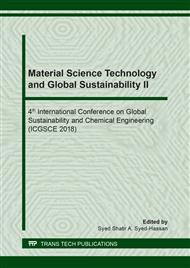[1]
Adam, A. Z., Lee, S. Y., & Mohamed, R. (2017). Pharmacological properties of agarwood tea derived from Aquilaria (Thymelaeaceae) leaves: An emerging contemporary herbal drink. Journal of Herbal Medicine, (June). https://doi.org/10.1016/j.hermed.2017.06.002.
DOI: 10.1016/j.hermed.2017.06.002
Google Scholar
[2]
Akpinar , E. K., & Bicer, Y. (2004). Modelling of the drying of eggplants in thin-layers. International Journal of Food Science & Technology, 273-281.
DOI: 10.1111/j.1365-2621.2004.00886.x
Google Scholar
[3]
Ali, M. A., Yusof, Y. A., Chin, N. L., Ibrahim, M. N., & Basra, S. M. (2014). Drying Kinetics and Colour Analysis of Moringa Oleifera Leaves. Agriculture and Agricultural Science Procedia, 394-400.
DOI: 10.1016/j.aaspro.2014.11.055
Google Scholar
[4]
Arslan, D., & Ozcan, M. (2011). Dehydration of red bell-pepper (Capsicum annuum L.): Change in drying behavior, colour and antioxidant content. Food and Bioproducts Processing, 504-513.
DOI: 10.1016/j.fbp.2010.09.009
Google Scholar
[5]
Chin, S. K., Siew, E. S., & Soon, W. L. (2015). Drying characteristics and quality evaluation of kiwi slices under hot air. International Food Research Journal, 2188-2195.
Google Scholar
[6]
Ertekin, C., & Yaldiz, O. (2003). Drying of eggplant and selection of a suitable thin layer drying model. Journal of Food Engineering, 349-359.
DOI: 10.1016/j.jfoodeng.2003.08.007
Google Scholar
[7]
H Alwi, M Zaki, N Asyikin, N Che Radzi, M Rodhi, M Najwa, MA Ami, KHK Hamid (2017). Heat Effects from Far-Infrared Source towards Antioxidant Activity in Aquilaria subintegra Leaves. Materal Sciences Forum 890, 146-149.
DOI: 10.4028/www.scientific.net/msf.890.146
Google Scholar
[8]
Karathanos, V. T. (1999). Determination of water content of dried fruits by drying kinetics. Journal of Food Engineering, 337-344.
DOI: 10.1016/s0260-8774(98)00132-0
Google Scholar
[9]
Kocabiyik, H., & Tezer, D. (2008). Drying of carrot slices using infrared radiation. International Journal of Food Science & Technology, 953-959.
DOI: 10.1111/j.1365-2621.2008.01767.x
Google Scholar
[10]
Krishnamurthy, K., Khurana, H. K., Soojin, J., Irudayaraj, J., & Demirci, A. (2008). Infrared Heating in Food Processing: An Overview. Comprehensive Reviews in Food Science and Food Safety, 2-13.
DOI: 10.1111/j.1541-4337.2007.00024.x
Google Scholar
[11]
Lahsasni, S., Kouhila, M., Mahrouz, M., & Jaouhari, J. (2004). Drying kinetics of prickly pear fruit (Opuntia ficus indica). Journal of Food Engineering, 173-179.
DOI: 10.1016/s0260-8774(03)00084-0
Google Scholar
[12]
Mark Sircus (2009). Magnesium: The Lamp of Life – Chlorophyll, DNA, DHEA and Cholesterol, IMW Publications.
Google Scholar
[13]
NAM Zaki, M Yusoff, H Alwi, KHK Hamid (2015) Total Phenolic Content and Alpha-Amylase Inhibitor from Aquilaria Malaccensis Leaves by Water-Based Ultrasonic Extraction.
Google Scholar
[14]
Pathare, P. B., Opara, U. L., & Al-Said, A.-J. F. (2013). Colour Measurement and Analysis in Fresh and Processed. Food Bioprocess Technol.
DOI: 10.1007/s11947-012-0867-9
Google Scholar
[15]
Razak, A. N., Shaari, A. R., Jolkili, M., & Leng, L. Y. (2016). Drying Curves and Colour Changes of Cassia.I nternational Conference on Green Design and Manufacture 2016, 1-5.
Google Scholar
[16]
SKN Afiffudden, H Alwi, KHK Hamid (2015) Determination of 4'-hydroxyacetanilide in leaves extract of Aquilaria malaccencis by high pressure liquid chromatograph, Procedia-Social and Behavioral Sciences 195, 2726-2733.
DOI: 10.1016/j.sbspro.2015.06.381
Google Scholar


